10 Tips You Need When Making Cacio E Pepe, From Three Professional Pasta Makers

If you or a loved one surfed the internet for food-related things around 2017, you may have been exposed to cacio e pepe. Should you have worked in the kitchen with cacio e pepe, you might have even been put at risk of crashing and burning on a dish that looks easier to make than it is. At the very least, you potentially caught strays from dogmatic writers who negatively opined about the pasta trend. Now that it's been proven how long this pasta has lived in the foodie consciousness, you are entitled to compensation. (The educational variety.)
Despite consisting of precious few main components and having 200-plus years of trial-and-error testing, the only thing that's simple about cacio e pepe is how easy it is to mess it up. Internet charlatans credit it with having only three ingredients — pasta, cheese, and pepper — but when you get down to the nitty-gritty, there can actually be upwards of 10-plus pieces (or sub-ingredients) to make this dish. It's notoriously clumpy, and its glossy sauce can turn watery in an instant.
To clarify some tips for making better cacio e pepe, I turned to some practiced hands. Two of Washington D.C.'s top pasta-slinging chefs contributed: chef Nicholas Stefanelli of the Michelin-starred Masseria, and Michael Friedman, chef of The Red Hen and newly opened Aventino in Bethesda, Maryland. To ensure both coasts had a voice in the conversation, I also spoke with chef Rob Gentile of Stella, located in West Hollywood, California.
Read more: 13 Unexpected Ingredients To Elevate Lasagna
Look For A Dry Pasta With A Rough Texture

Without pasta, cacio e pepe is just a sauce. That can be useful in its own right, but chances are you're not looking for advice on sauce alone. It's pasta at the core of this dish, which means it's important you get the right type. Pasta type can make the difference between a sauce that sticks or a sauce that pools on the bottom of the plate.
For a traditional cacio e pepe, spaghetti is needed. Spaghetti bucatini works particularly well to remedy the sauce issue, since it has a hole that runs down the center and acts as a reserve. However, for chef Michael Friedman, the classic tonnarelli pasta is the best option. He says, "It has the most toothsome nature to it." Tonnarelli is a semolina-egg pasta; it's also typically extruded through a bronze die — a vital piece of info to know.
Pasta shape is certainly an important factor, but it's not the only factor. After all, chef Rob Gentile recommends a short pasta type, but he's sure to clarify that whatever the shape, home cooks should use fresh pasta. Both fresh pasta and a dry semolina pasta like tonnarelli share something in common: Each tends to have a rougher texture, which is the crucial factor for making cacio e pepe sauce stick. Within reason, the rule goes that the rougher the pasta, the more porous it is. And a more porous pasta means your sauce will adhere better.
Pecorino Is Traditional, But A Mix Of Cheese Is Best
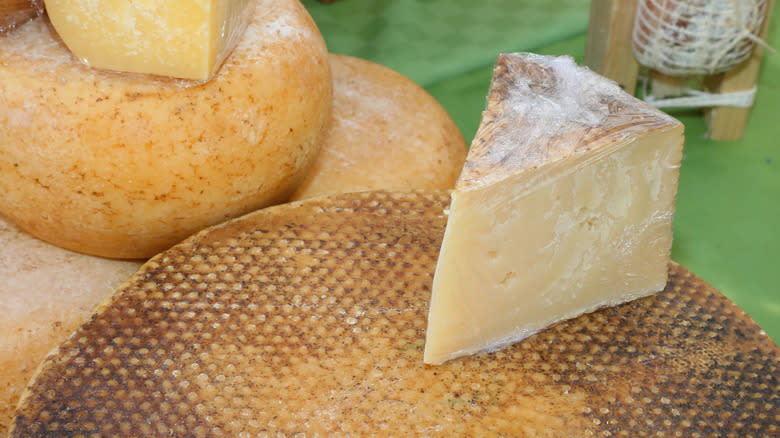
Cacio e pepe is an old, practiced dish. That means it has certain "rules" to follow and controversy to deal with when you don't. For example, many say there's only one cheese you should use in cacio e pepe. If you're a purist in your cooking, respect. (Also, thanks for leaving more cheese to the rest of us.) Pecorino Romano is the true, classic cacio for this pasta. That said, every chef I spoke with suggests you should pull more than one cheese from your pantry. Dear reader, that's right: the professionals say blend it. A mix of Parmigiano Reggiano and pecorino Romano is a good place to start.
"I believe that there needs to be a ratio," says chef Michael Friedman. "Because you want to be able to balance the salty, funky nature of pecorino Romano with Parmesan, something that's a little sweeter, a little bit nuttier." Friedman further spills that most professional kitchens use a mix, but ratios tend to be a deeply protected secret.
Rob Gentile, who's clearly a tough nut to crack, tells us, "I like a blend of 70% pecorino, 25% Parmigiano Reggiano." Chef Nicholas Stefanelli plays his ratio closer to the chef's coat but adds an additional name to the conversation. "We do a cacio de Roma, which is a table cheese that comes from Lazio," Stefanelli says. Like pecorino, cacio de Roma is a sheep's cheese. It's softer, however, allowing it to more readily melt.
A Fondue Is A Good Method For Emulsifying Cacio E Pepe
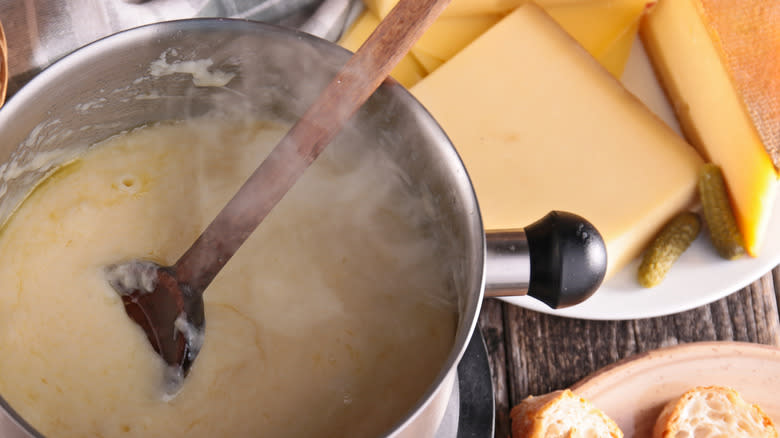
One of the trickiest parts of building cacio e pepe is getting a fully emulsified sauce. The most common pitfall is ending up with something that's clumpy, or a broken sauce with a ring of separated moisture around the edge. Chef Nicholas Stefanelli of the Michelin-starred Masseria has an unexpected cacio e pepe tip that helps improve the combination of ingredients into a slick and smooth coating. He recommends creating a separate, fondue-style sauce. This isn't the slightly tangy, wine-based mix you might be thinking of.
"It's not like your traditional kind of Mornay sauce or fondue where it's a bigger flour ... and milk ratio," says Stefanelli. "We use just a little bit [of] water; we don't use milk." If you think Stefanelli is playing fast and loose with the term fondue here, you're not alone. Essentially, the chef recommends that you use a touch of butter and flour in combination with your pasta water and grated cheese, which will help the components of your sauce stick to each other and keep from breaking.
In this method, the pasta and sauce are added separately. The trick to making this sauce taste like cacio e pepe, rather than a roux, is patience. "You want to make sure when you're cooking the base of the fondue that you give it some time to cook the flour out," adds Stefanelli.
Be Cautious With Your Grating Size
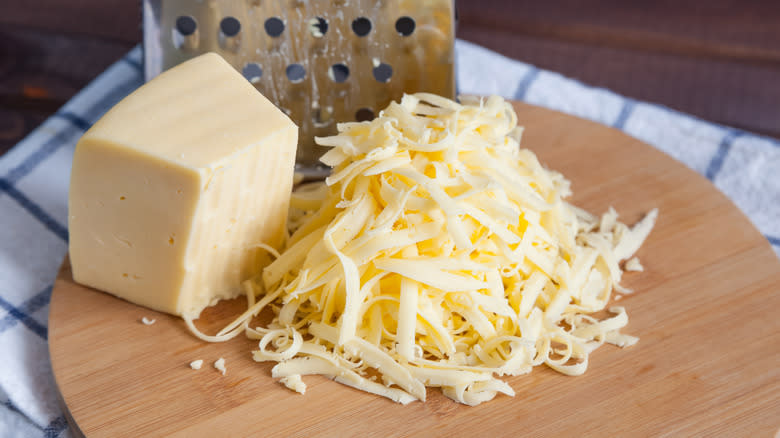
If adding flour isn't what you want to do, there are plenty of ways to get that glossy cacio e pepe consistency. One factor is the size at which you're grating your cheese. It takes some trial and error to figure out what works though, and there's conflicting schools of thought between chefs as to what works best. Per chef Michael Friedman of The Red Hen, the smaller, the better. "You need a really finely ground cheese," he says, adding, "If you have a thicker grated Parmesan or pecorino, it will clump because ... its structure is too large."
On the flip side, Nicholas Stefanelli recommends keeping the size a bit larger. He opts for a regular box grater, saying, "With a microplane, it tends sometimes to get too fine. So, it's really [important to give] it some time so it melts and allows to dissipate properly." Naturally, there's wisdom in both approaches.
Pecorino has a very high melting point, so a finer shred can ensure it melts better and faster. However, if all of that powder isn't spread evenly, it can lead to lumps in your sauce as mounds coagulate together. Longer shreds, such as those from a box grater, will melt slower. But they have the benefit of spreading more evenly. Regardless of what size you choose for grating, a couple standard rules should be followed: Take it slow with adding cheese but be fast with incorporating it. You should vigorously whisk in a few pinches at a time.
Proper Temperature Management Is Crucial
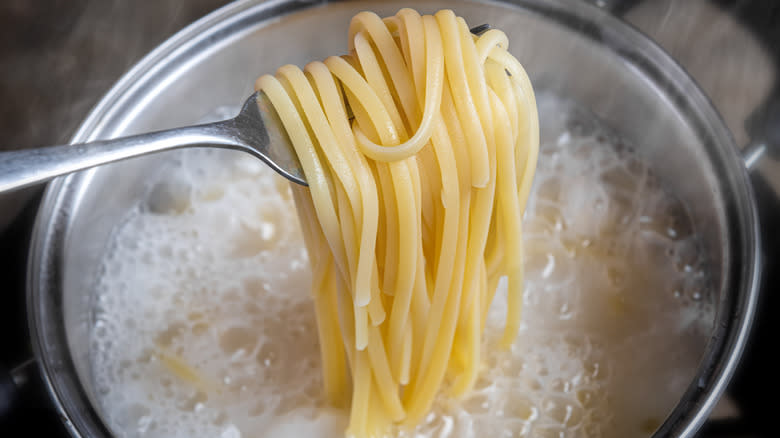
The internet is full of different methods for making cacio e pepe. Go on YouTube, and Babish will tell you to use a blender for your sauce while J. Kenji López-Alt incorporates everything directly into a pan. Most likely, the method you're going to use for bringing this dish together goes through these steps: Par-cook your pasta in a pot while you toast your pepper in a pan. Transfer your pasta to the pepper pan with some pasta water, add cheese, and stir rapidly. However you build your cacio e pepe, all three chefs that I spoke with mention heat as a variable that needs attention.
"It's a balance and a chess match of heat and stirring," says chef Michael Friedman. He tells us that if your pan is too hot, you risk a breakdown of your sauce where the cheese and water separate. Too cold, and the cheese will clump without melting. So, how is one supposed to introduce heat into the process? According to chef Rob Gentile, just leave it out.
Gentile says, "No additional heat is required, just hot water from the pasta cooking pot." Friedman agrees. In his process, once the pasta is cooked in the boiling pan, he combines it with cheese in the pepper pan and removes it all from the fire. If more heat is needed, he adds hot pasta water to the cacio e pepe; if there's too much water, he kicks the flame back on momentarily to simmer it off.
Use More Than One Type Of Pepper In Cacio E Pepe
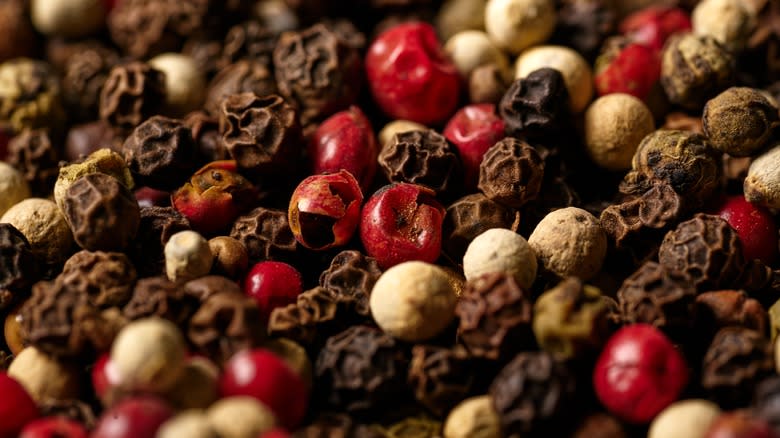
The world of pepper is vast, and we're all lucky that it is. The type of pepper you choose deserves your attention. Asked what pepper goes into his cacio e pepe, Nicholas Stefanelli tells us black, white, and only a small amount of Sichuan. For the cacio e pepe that chef Rob Gentile serves at Stella, the blend also consists of white and black peppercorns from Sarawak, Malaysia. Gentile also uses cubeb peppercorn and black long pepper. The latter spice adds a depth reminiscent of garam masala, while the white Sarawak brings bright heat.
Per chef Michael Friedman, it's uncommon to see white peppercorns in Italian cooking. Still, he seconds Gentile on the use of cubeb, which has a persistently aromatic taste. Friedman also uses tellicherry and kampot. Kampot is known by many as the "champagne of peppers" due to its varying levels of spiced floral notes. He points out that you can expand the color palette of your peppers even further by following the example of chef Missy Robbins, who makes a famous cacio e pepe with mafaldine pink peppercorns.
Pick all the peppers you want, but it won't make much difference if you neglect to bloom your spices. As your water boils and your pasta cooks, toasting your pepper in a separate pan will elevate your cacio e pepe. Doing so brings out hidden layers of taste, so long as you're careful not to burn your spices.
Butter Is Controversial But Makes A Better Emulsion
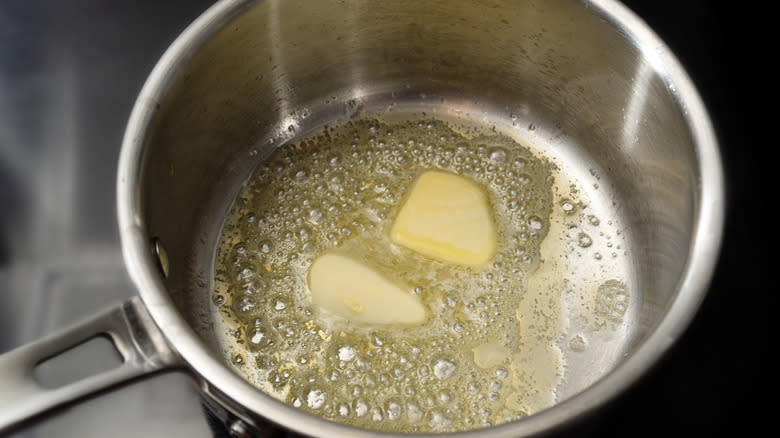
Mention butter and cacio e pepe to a Roman, and they might say ... "good idea!" Romans aren't a monolith, and maybe you're talking to someone who's interested in tips for improving cacio e pepe. More likely, you'll catch flack, but not from these chefs.
"Realistically, [in] this dish, there's just not any fat that goes into it," reminds Nicholas Stefanelli. "It's the pasta water with the cheese itself that emulsifies together, and that's what makes it the most challenging." Fellow D.C. chef Michael Friedman extolls butter as essential. "If you're new to cacio e pepe making, I urge you to add a little bit of butter," he says. "Because it adds enough fat to the pasta water to help that cheese incorporate." On the West Coast, Rob Gentile uses it to mellow the flavors of peppercorn and sharper cheese in the cacio e pepe.
Using butter is akin to adding a splash of dairy to your cacio e pepe. Both butter and cheese have lipoproteins which are essential for bonding. Aged cheese like pecorino or Parmesan have fewer lipoproteins by the time they arrive in your kitchen. Butter, however, has more readily available lipoproteins. (Bad for cholesterol, but good for bonding.) After toasting pepper in olive oil, add a knob of butter to the pan. Mix in par-cooked pasta, and whisk in cheese. Watch the way the sauce and flavor come together — maybe the Romans will do as you.
Cacio E Pepe Sauce Is Great Without Pasta

With luck, these tips will give you the tools you need to make cacio e pepe well. Do that, and you'll probably see it regularly. Like any long-term relationship, though, be wary of things becoming routine. You need to get creative if you want to keep the spark alive, and the pasta pros have some suggestions for just that. "Think of steak and cheese," says chef Nicholas Stefanelli. (For us, cheese and pepper slathered on strips of meat sounds drool-worthy.) But if spreading this sauce on buns seems too casual for trying to rekindle a serious connection, he also recommends dressing it up by serving it over a low-and-slow cooked risotto.
Mike Friedman also leads with a casual meeting of flavors, sharing that he's been known to sling a cacio e pepe pizza. A signature dish at his restaurant, however, is cacio e pepe arancini. As a unique twist, he says the flavors even go well on bagels. Rob Gentile knows a thing about slow burning and says he keeps the fire alive, literally. At Stella, the current move is finishing wood-charred sugar snap peas with cacio sauce and some Italian truffles.
Even canned tuna fish can get the cacio e pepe treatment. Overall, think of the dish like your crush next door. It's down to earth. It has substance. But that doesn't mean you can get by with treating it as average. Dress it up and turn something simple into something special.
Consider A Garnish For Greenery, And New Ingredients For Updated Flavors
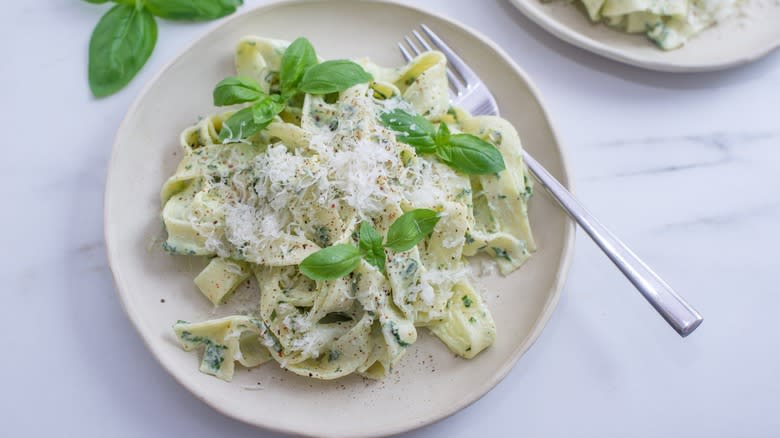
A garnish of green parsley is one way to freshen up your cacio e pepe, but we understand if you're hesitant to go for more. A rose by any other name might smell as sweet, but does cacio e pepe by any other ingredients still taste as savory? Ultimately, that's subjective and depends totally on how willing you are to break the rules.
Need an accomplice? Follow the guidance of chef Rob Gentile, who makes a fungi-forward pasta. "At Stella, we love adding fresh truffles and truffle oil," he tells us. If you don't happen to have any on hand, Gentile has suggestions for some more readily available pantry ingredients. "A really fun addition to a cacio e pepe is just a raw egg yolk on top," he says. "Kind of like a cross between a carbonara and a cacio e pepe."
For some cooks, shallots are a secret ingredient that gives cacio e pepe a slightly sweet and earthy allium flavor, but without changing the essence too much. A fellow Tasting Table writer even once risked it all by suggesting you swap your starchy pasta water with sweet corn stock while making cacio e pepe. It's a wildly left-field suggestion with some serious summertime merit. Your choice might not be "traditional," but take this encouragement to make this dish what you wish. Your kitchen is a safe space.
Serve Your Cacio E Pepe Immediately

Although it appears simple, when you break it down, cacio e pepe has a lot of moving parts — and more pieces than you probably thought. The more you practice, the better you'll get. As many times and ways as you tweak the volume of pasta water, the temperature, your cheese blend, or your pepper mix, one thing you need to do consistently is serve cacio e pepe immediately.
Unlike a pesto, a Bolognese, or even a vodka sauce, the emulsion of cheese in cacio e pepe isn't just temperamental, it's downright finicky. Wait too long, and it may split. Even if your sauce appears strongly bonded when hot, you might end up with a clumpy, goopy mess as soon as it cools. So don't wait! Take the opportunity to sit down and enjoy the fruit of your labor right away. There's always time to clean the kitchen later.
Read the original article on Tasting Table

